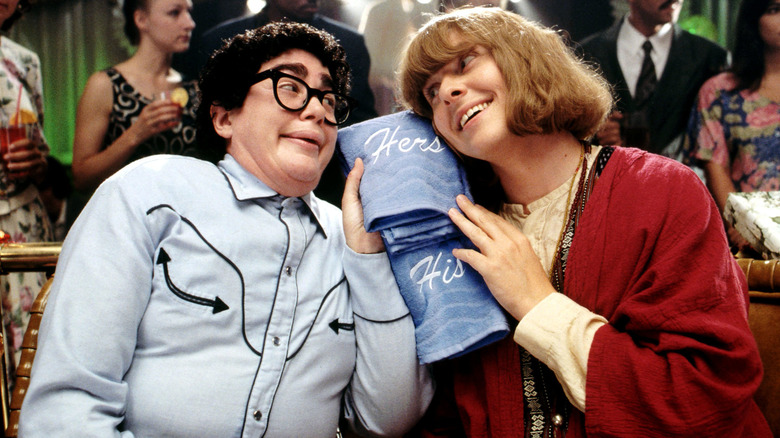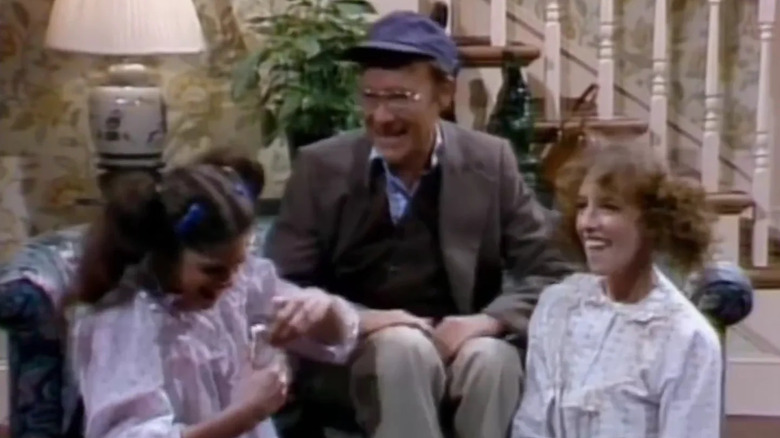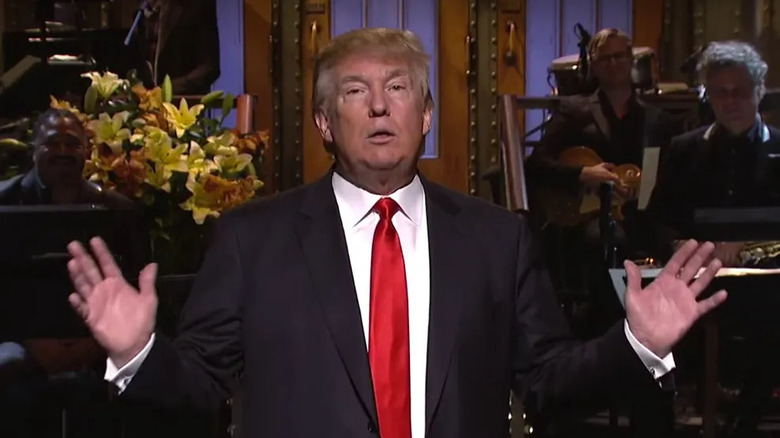SNL Called Out 50 Years Of Poorly Aged Sketches, But They Didn't Go Hard Enough
When Tom Hanks took the stage late during last night's 50th anniversary celebration of "Saturday Night Live," he appeared to be headed into somber territory. The lights were dimmed to blue, his tone was reverent and, as he worked into his prepared comments, the subject one that hits so very close to home for the show's alumni and friends. "As we celebrate the achievements of the past 50 years," he said, "We must also take a moment to honor those we've lost. Countless members of the 'SNL' community taken too soon." Hanks paused briefly for effect, then continued. "I'm speaking, of course, about 'SNL' characters that have aged horribly."
No comedic institution can last 50 years without finding the third rail on occasion. For "SNL," a sketch comedy series both emerged from and tore apart 1960s counterculture humor, jolting viewers with gasp-inducing gags that seemed to fly under snoozing network censors' radars at 11:30 PM was what set it apart from such play-nice primetime series as "The Carol Burnett Show" or "The Sonny & Cher Comedy Hour." Sure, it was fun to see the original Not Ready for Prime Time Players don goofy costumes and play The Coneheads or The Killer Bees, but knowing that Buck Henry might turn up as fun-loving pedophile babysitter Uncle Roy gave the show a ferociously unsettling charge. We shouldn't be laughing at stuff like this at all, but the unspeakably awful absurdity of the situation (knocked into the comedy stratosphere by Gilda Radner and Laraine Newman as the rambunctious nieces) made it all caustically hilarious. To what end?
Henry's Uncle Roy unsurprisingly turned up in the four-minute clip sequence introduced by Hanks, which was part mea culpa, and part indictment of viewers for having laughed at these skits when they initially aired. If you're wondering how four minutes was possibly long enough to cover 50 years of wildly insensitive if not outright hurtful comedy, it wasn't. But since "SNL," which isn't big on self-reflection, trots out the closest thing we have to Jimmy Stewart to make half-assed amends, it's hard not to marvel at the half-assedness.
SNL boasts a deeply problematic 50-year history
The bad taste "In Memoriam" (which you can watch here) kicked off with John Belushi in yellowface as his samurai character (lovingly patterned after the great Toshiro Mifune), and sprinted through decades of cast members shamelessly embodying racial stereotypes. The clip reel also included body shaming, gay panic, acts of sexual harassment and assault played for laughs, two guests who were found liable in a civil court for wrongful deaths (O.J. Simpson and Robert Blake), and two others who have either been found guilty of or are awaiting trial for sexual assault (R. Kelly and Sean "Diddy" Combs).
When it came time to show actors wearing makeup and appliances to portray people of different races and ethnicities, faces were blurred to protect the not-so-innocent — presumably because they know better now (or, like Billy Crystal who generated controversy in 2012 by revisiting his Sammy Davis Jr. impersonation at that year's Academy Awards, have decided no apology is necessary). The segment concluded with the classic skit featuring Chevy Chase and Richard Pryor trading rapidly escalating ethnic barbs (which ironically, in this iteration, undercut Pryor's biggest laugh by bleeping out Chase's use of the n-word).
Like many mainstream showbiz institutions of its era, "SNL" was mostly white and, behind the scenes, dominated by men. The show wouldn't have a female head writer until 1999 (Tina Fey), and didn't have a POC head writer until 2017 (Michael Che). The producers tended to be white men as well, and you needn't ask about the racial/gender composition of the network charged with overseeing the series. So a lot of the edginess that made "SNL" truly controversial was infused by guys with immensely privileged points of view. Had this been acknowledged, I think that four-minute clip reel would've looked radically different.
SNL wants you to forget Donald Trump hosted the show in 2015
Once Lorne Michaels and everyone else in charge of producing "SNL 50" decided that this segment would include past problematic guests, they invited an elephant into Studio 8H. And by not reminding viewers that President Donald J. Trump, a convicted felon who was found liable in 2023 for defamation and sexual abuse against E. Jean Carroll, hosted the show in 2015, they demonstrated abject cowardice in a moment that didn't even call for bravery. The facts are the facts. Instead, they memory-holed the lowest point in the series' 50-year history and sent a message to the public that Trump is, at present, too powerful to be lampooned.
The producers also would've done well to address Julia Sweeney's Pat, an androgynous character from the early 1990s whose uncanny sexlessness sent people into a tizzy speculating as to their gender identity. Though Sweeney dropped by "The View" recently to discuss Pat's troubling legacy ("Transparent" creator Joey Soloway claims that the character was a "hateful, hateful, awful thing to do to non-binary people"), sweeping the character under the rug on "SNL 50" was hurtful at a moment when trans people's very existences are being erased by the government. Perhaps the wound of Pat is too raw and infected at this unfortunate juncture in American history to be referenced in drive-by fashion. Personally, it felt thoughtless not to go there at all.
Obviously, no one tuned in to "SNL 50" on Sunday hoping for this anniversary broadcast to mend all fences and save the republic in three hours and change. The show hasn't been at the vanguard of comedy in decades and really wasn't meant to be there in the first place. If you wanted laughs that drew blood in the 1970s, you read "National Lampoon" or watched the stand-up of Richard Pryor and George Carlin. "Saturday Night Live" offers escape, not excoriation. Comedically, it's a sign of what the times will bear and nothing more.


